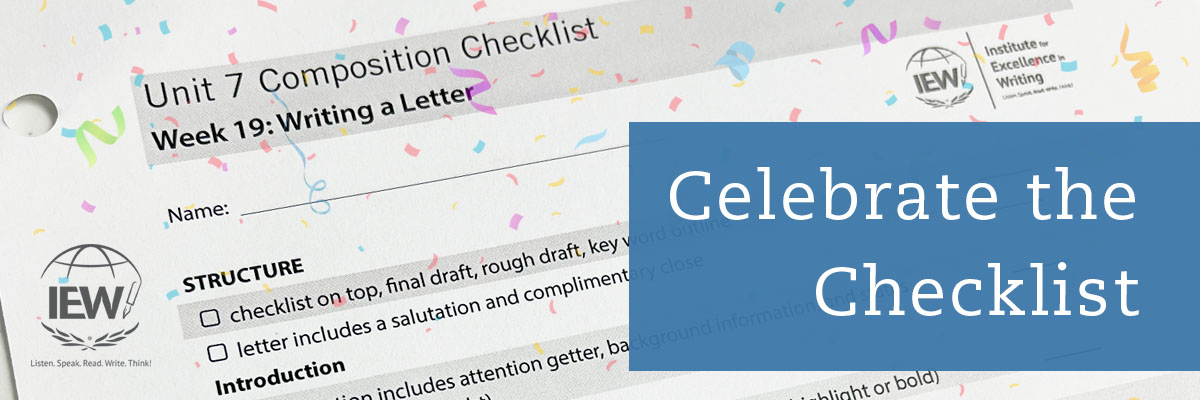
Oh, checklist, how do I love thee? Let me count the ways. True, loving the IEW checklist is probably going too far, but when used properly, it can be a lovely thing. From structure through style to mechanics, the checklist makes it easy to objectively grade student papers. It also helps students know exactly what is expected of them. Below are a few tips to help make the checklist work for you:
-
Demonstrate how to apply the checklist. I think this is the most common difficulty among students. I have had them dutifully return their assignment without a single check mark on the checklist. Clearly, they need to be shown how to use it! Model its use. After writing a paragraph as a class, show students how to use the checklist point by point to check the composition before considering it finished. As you touch on each point, such as “MLA Formatting” or “-ly adverb,” explain what it means and how to ensure it is correct. Have your students consider, “Can this be checked off, or does something need to be changed?” Sadly, students will not internalize this on the first try. You will likely need to demonstrate its use many times before students will use it correctly.
-
Follow the “EZ+1” method. Just because a new dress-up or sentence opener has been taught to the class does not mean that it should be added to the checklist. Everything on the checklist should be easy except for one thing that is a bit of a challenge. Students like to do what they think they can do. If the checklist has been properly demonstrated, and it contains mostly what students can do easily, it will not discourage them. But if all they see is a mass of style that they are not sure about, then it will be enough to make them want to throw up their hands in despair.
-
Individualize the checklist. Ideally, each student’s checklist should apply to their unique ability. With this in mind do not rush to add newly taught stylistic techniques to the checklist. Instead, invite students to add the new style to their checklist if they are up to the challenge. This lets the bold writers move forward while those who need more time are not frustrated. As possible, ensure the checklist is EZ+1 for each student.
-
Add specifics to the checklist. When students have specific areas where they forget things, such periods at the ends of sentences, proper date format, or commas with #5 openers, add them to the checklist. The checklist is there to help students succeed!
-
When students struggle, help them. You cannot help too much. Model the application of style with each writing assignment. Work together to come up with options for strong verbs or how to get a sentence to start with a legal #4 opener. This makes completing the checklist much easier and is especially important for those who struggle. Modeling is not a handout; it is a hand-up that will build skill in your students over time.
-
If students balk, challenge them. Some students complain about having to include all the style elements each and every time. Encourage them that continuing to fulfill the checklist is like running with weights; it builds writing muscle. If they complain that their writing would be better without the requirement of all the style, encourage them that the discipline that comes from wrestling with the words will pay off in the future. When they are finally freed from the checklist, they will have a plethora of writing tools right at their fingertips.
-
Have students create their own checklist. This is especially helpful to older students who will soon be writing for other people. Give them a writing prompt with the specifics offered in prose, such as “vary sentence style” or “include three quotations,” and show students how to create a checklist from the prompt. In school and at work, writing is done for a professor or a boss and needs to be done to their expectations. A checklist will help a student achieve excellence in that endeavor.
The beauty of the IEW checklist goes far beyond its role as an objective grading tool. It gives teachers and teaching parents a flexible framework for teaching. It provides students a way to strengthen their skills without discouraging them. Best of all, it encourages excellence in writing and beyond. The checklist is indeed a lovely thing. Celebrate it!
|
Jill Pike is a homeschooling mother of eight and an IEW® Accomplished Instructor. Serving the homeschool community, she provides support to thousands of teachers and parents. She has authored many lesson plans offered by the Institute for Excellence in Writing, including IEW’s popular reading and writing program, Primary Arts of Language. After graduating seven children, Jill and her husband, Greg, continue to home educate their youngest in Indiana. |

